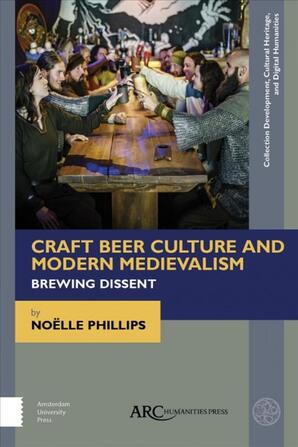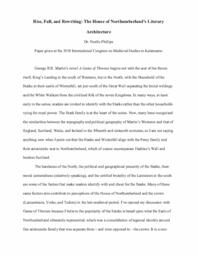Phillips, Noëlle
Person Preferred Name
Noëlle Phillips
Affiliation
Related Works
Content type
Digital Document
Description / Synopsis
"Few would dispute that Vancouver is a prime craft beer destination, with over 100 small-batch breweries currently in operation. Beer has shaped the city's culture, and in turn, Vancouver's idiosyncratic identity has also shaped its craft beer. But how did it all begin? Beer historian and enthusiast Noëlle Phillips follows independent brewing from the city's inception in 1886, into the onset of prohibition in 1917, and delves into the explosion of micro, small-batch and craft breweries that dot the city's neighbourhoods today. Illustrated with photos, original newspaper clippings, and maps, this book traces the smaller, lesser-known breweries, owners, and brewers through archival materials and personal interviews, uncovering stories and details that have been largely unknown even to local beer writers and aficionados. Making stops into sunlit tap rooms and basement archives, Brewmasters and Brewery Creek is an inviting and exciting new volume that speaks to brewers, beer lovers, and history buffs."-- Provided by publisher.
Origin Information
Content type
Digital Document
Abstract
"Beer and brewing in medieval culture and contemporary medievalism is a cross-cultural analysis of the role that alcohol consumption played in literature, social and cultural history, and gender roles in the Middle Ages. The volume also seeks to correct or offer new insights into historical beer production. By drawing on the expertise of scholars of history, archaeology, Old and Middle English, Old Norse, and Medieval and Early Modern literature, the book produces a sustained discussion of how beer and alcohol consumption in the Middle Ages directly contributes to the romanticized vision of the medieval ale-hall omnipresent in beer marketing today. The essays describe alcohol consumption in the Middle Ages across much of Northern Europe, engage with the various myths employed in modern craft beer advertising and beer production, and examines how gender intersects with beer production and consumption. The editors also raise certain critical questions about medievalisms which need to be interrogated, particularly in light of the continued use of the Middle Ages for white supremacist and colonialist ideals. The volume contributes to the study of the popular and historical understandings of the Middle Ages as well the issues of race and gender." --Page [4] of cover.
Origin Information
Content type
Audio
Description / Synopsis
Selection from the <a href="https://open.spotify.com/show/3d9K0ATvbNadhXi0KtYcWq">Canterbury Fails</a> podcast hosted by David Coley and Matt Hussey. This episode, "A Very Special Episode Live from the International Congress on Medieval Studies" was recorded at the <a href="https://wmich.edu/sites/default/files/attachments/u385/2023/2023CongressProgram.pdf">International Congress on Medieval Studies, Kalamazoo, Michigan (May 11-13, 2023)</a>. In this section, Noëlle Phillips and Carissa Harris discuss John Lydgate's poem, <i>Ballad on an Ale-Seller</i>.</p>
Origin Information
Content type
Digital Document
Origin Information
Content type
Digital Document
Abstract
"Modern editions of medieval texts, with their cleanness and clarity, offer ease in reading yet often eliminate the interpretive signposts that would have guided the medieval reader: capitals, parafs, large rubrics, and smaller secondary rubrication. Because traditional editions do not (and, practically speaking, cannot) reproduce such features, these visual reading cues tend to remain invisible to us even when we are given the opportunity to see the page in its entirety. Rubrication is one of these visual cues. Most manuscripts that contain rubrication include two types: large red lettering used for Latin and textual divisions, and smaller red-ink touches on the regular ink. In this article I use “rubric” for the former and “rubrication” or “secondary rubrication” for the latter. Secondary rubrication includes dots, dashes, and underlining, all of which could be done quickly and without much pre-planning or expertise. Rubrication is one of the ways in which scribes structured the page; it may seem minor, but it can tell us a great deal about the scribe’s own interpretive framework. In addition to rubrication’s aesthetic pleasure - the visual alleviation it provides on a page of close-set script - it also offers pleasure of a different sort, since it helps a reader negotiate the manuscript and therefore enhances the reading experience as a whole. Even the absence of rubrication can affect the reader’s interpretation of a text. In a manuscript relying heavily upon rubrication, the words that the scribe chooses not to emphasize can be just as revealing as those he does ..."--From publisher description.
Origin Information
Content type
Digital Document
Abstract
Since the 1970s, the craft brewing industry has grown in popularity. However, with the introduction of the Internet and the consequent globalization of cultures and economies, craft beer marketing has increasingly evoked the medieval past in order to appeal to our collective sense of a lost community, and even a lost purity. This book discusses the desire for the local, the non-corporate, and the pre-modern in the discourse of craft brewing, which has become a form of ideological resistance to corporate capitalism, forming a strong counter-cultural narrative. However, such discourses also reinforce colonial histories of purity and conquest while effacing Indigenous voices, and there are troubling intersections between the desire for a medieval past and the desire to preserve the imaginary 'whiteness' of that past. Such considerations are particularly relevant now, during a time in which white nationalist groups (many of which turn to a medieval past for inspiration) are increasing in influence and visibility. Moving from beer in the Middle Ages to beer in 2019, this book deploys analysis of literary and historical texts, advertisements, labels, and interviews with craft brewers and writers to argue that craft beer is much more than a delicious drink and a social connector; its marketing, its appeal, and its ubiquitous presence in middle class North America reveals a powerful cultural desire for the past in a world that privileges the present. Part of the "Collection development, cultural heritage, and digital humanities" series. --From publisher description.
Origin Information
Content type
Digital Document
Abstract
Presented at the <a href="https://wmich.edu/medievalcongress">International Congress on Medieval Studies, (Kalamazoo, Michigan, 2018)</a>. George R.R. Martin's novel A Game of Thrones begins not with the seat of the throne itself, King's Landing in the south of Westerns, but in the North, with the Household of the Starks at their castle of Winterfell, set just south of the Great Wall separating the brutal wildings and the White Walkers from the civilized folk of the seven Kingdoms. In many ways, at least early in the series, readers are invited to identify with the Starks rather than the other households vying for royal power. The Stark family is at the heart of the series. Now, many have recognized the similarities between the topography and political geography of Martin's Westerns and that of England, Scotland, Wales, and Ireland in the fifteenth and sixteenth centuries, so I am not saying anything new when I point out that the Starks and Winterfell align with the Percy family and their aristocratic seat in Northumberland, which of course encompasses Hadrian's Wall and borders Scotland.
Origin Information







